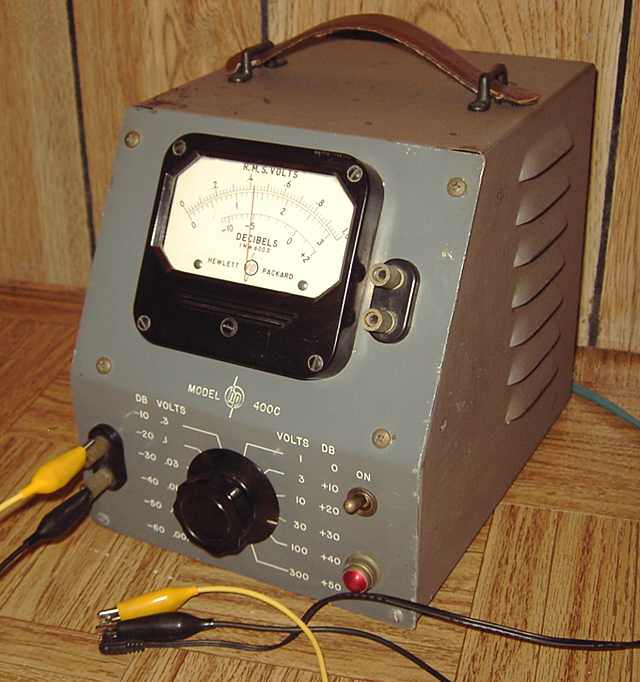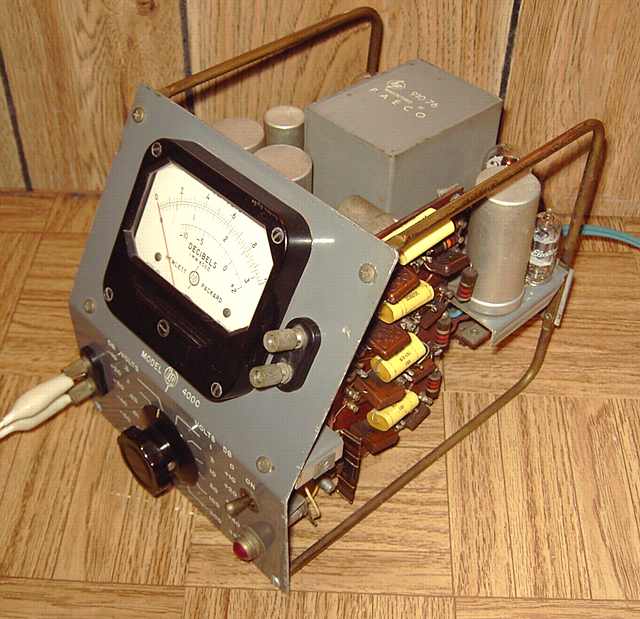
Having previously repaired a Hewlett-Packard HP-400D Vacuum Tube Volt Meter, I was curious to see how the older model 400C compared to it. It is a more compact instrument dating from 1948 as an improved model of the first of the series, the HP-400A which was first introduced in 1942-43. Price of the HP-400C was $200.
Like the HP-400D, the HP-400C is a wide-band RMS voltmeter and amplifier. Like its newer sibling, it is capable of reading AC from 1 millivolt full scale to 300 volts full scale. However, its wideband frequency capability is about half that of the 400D. The 400C has an upper working limit of 2 Megahertz whereas the 400D has a working accuracy to 4 MHz . Both offer service as a wideband amplifier, using the terminals on the upper right side of the case.

Unlike the 400D, I did not have a manual or schematic when I repaired this 400C. Block diagrams of the main circuit functions for both are similar, but the tubes are different. Altogether there are 10 tubes shoe-horned into this very compact 400C package, the size of which is the same as the original 400A. The 400C uses four 6AK5 amplifier tubes. The input cathode follower is a 6SQ7. An amperite ballast tube is included to keep the filaments of V1 through V5 at about 6.3 volts DC. Like all the 400 models, the C model has regulated B+ voltage. Power supply tubes include a 6X5 rectifier, an 0A2 regulator, a 6AV6 error amp, and a 6AU5 pass tube. A low-voltage solid state rectifier supplies DC for the amplifier tube filaments. The circuit in this 400C is the later one for serial numbers 1360 and higher. Serial numbers lower than 1360 use a 5Y3 rectifier and a 6V6 or 6Y6 pass tube. Those earlier serial numbers only provide DC filaments for V-1 to V3 and do not include the ballast.
Repairs
Problems with this HP-400C were similar to those encountered with the 400D. The symptoms were inability to zero and low readings.
Like the 400D repair, I isolated the final amp stage by pulling the tube previous to it. That left just the final 6AK5 in the circuit to the meter. The inability-to-zero problem was caused by a leaky 1 MFD capacitor feeding the meter diodes. Replacing the cap solved that problem. One of the 6AK5 tubes tested weak and was replaced. While that made a slight improvement in sensitivity, the meter still read low. I suspected the coupling caps in the amp circuit to be somewhat leaky. Replacing all of them brought the meter sensitivity up to expectations with plenty of margin for the voltage adjustment rheostat.

Double duty as a power supply
The compact 400C meter is useful in many ways but can also be used for a purpose never intended by HP. Its regulated 220 volts can be tapped using a simple voltage divider for feeding an outboard VFO or a battery-operated 1920's radio. The 6.3 volts DC filament supply can also be tapped using a cheap three-terminal 5 volt regulator for feeding the filaments of the 1920's radio. As one would expect of HP, the power supply is conservatively rated so a bit of power for outboard applications is possible.
Interesting uses
The HP-400C and the 400D have a very useful wide-band amp good for audio, VLF, and well past the broadcast band. Should be useful for checking crystal set gains or even listening to the output of the meter via a crystal and headphones while using a crystal set tuned circuit at the input to tune VLF or broadcast. Let me know what fun experiments you have performed with these HP meters.
A Zenith 6G001Y "Long Distance" Universal was the previous item on the bench.